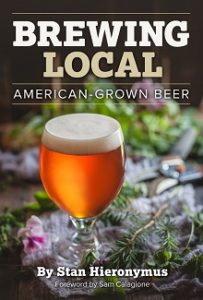 Confession. I have fed Stan in my home. I have been asked by Stan why he bothers discussing things with me. My name appears in this book. I am very fond of Stan. All of which may influence my opinion of his writings, of this book. Along with the fact that this was a review copy kindly forwarded from the publisher. Can’t help it. Heck, if I run the photo contest again this Christmas I might just give it away as the only prize. I’m like that.
Confession. I have fed Stan in my home. I have been asked by Stan why he bothers discussing things with me. My name appears in this book. I am very fond of Stan. All of which may influence my opinion of his writings, of this book. Along with the fact that this was a review copy kindly forwarded from the publisher. Can’t help it. Heck, if I run the photo contest again this Christmas I might just give it away as the only prize. I’m like that.
But let’s work around that for the moment. As with his other books for the Brewers Publications series, Stan has written a practical guide. Starting with the second half of the book, we see it contains discussions on foraging, a directory of ingredients one might consider adding to a beer to capture locality in the glass and, then, a collection of brewing recipes – including one for an 1835 Albany Ale supplied by Craig which has its roots in a report to the New York State Senate from that year which I discussed now over six years ago. It is flattering but at the same time something I consider important. Beer and brewing in the north end of the Western Hemisphere has a history which goes back at least 439 years – not counting the Viking expeditions. You would think it was invented by the immigrants who moved here after the varying successes of the 1830s revolutions in Europe. It wasn’t.
Much to his credit, Stan goes even further back and documents one beverage of one of the peoples who were here before European colonization: corn-based tiswin of the Apache. He also ties late 1800s Okalhoma choc with the Choktaw people who were relocated in the genocidal trail of tears two generations before. There would have been others – but they were not by any means pervasive according to a Senacan cultural botanist pal of mine. Yet it is hard to believe that the brewers of New Sweden in the 1650s making beer from local pumpkins, corn, persimmons and watermelons didn’t learn something from the locals.
What the depth and breadth of Brewing Local conveys is a picture of a complex and largely unexplored understanding of indigenous vernacular brewing on this continent. It is an exciting time to have an interest in such things. Stan emailed me earlier this year that he would have included my idea of “four eras of cream ale” had he come across it in time. I suspect I hadn’t even written it in any proper manner before he saw it. Months later, I got to hunting around “cream beer” dating back to the early 1800s with the hints of its pre-lager existence, its earlier German immigrant foundations and its potential links to later 1850s Kentucky Common. All of which might also be worthy of a footnote or two in this book. Had I written it. Had someone – anyone – looked it up. There is so much yet to be pursued.
Which is a good thing. Which makes for a very good book. Because the book is both history and guide, both a “how to” and also a “why” which ties a lot of things together in a way that hasn’t been done before. It’s a part of a bigger collective work in progress. [I don’t find fault that Stan, for example, doesn’t mention the reason I think steam beer is called steam beer but that is also part of the bigger working out of things. I could be dead wrong.] Does this make it a milestone book in North American brewing history? Could be. I’ll have to read it a more few times to form a full opinion on this book. You should, too.
